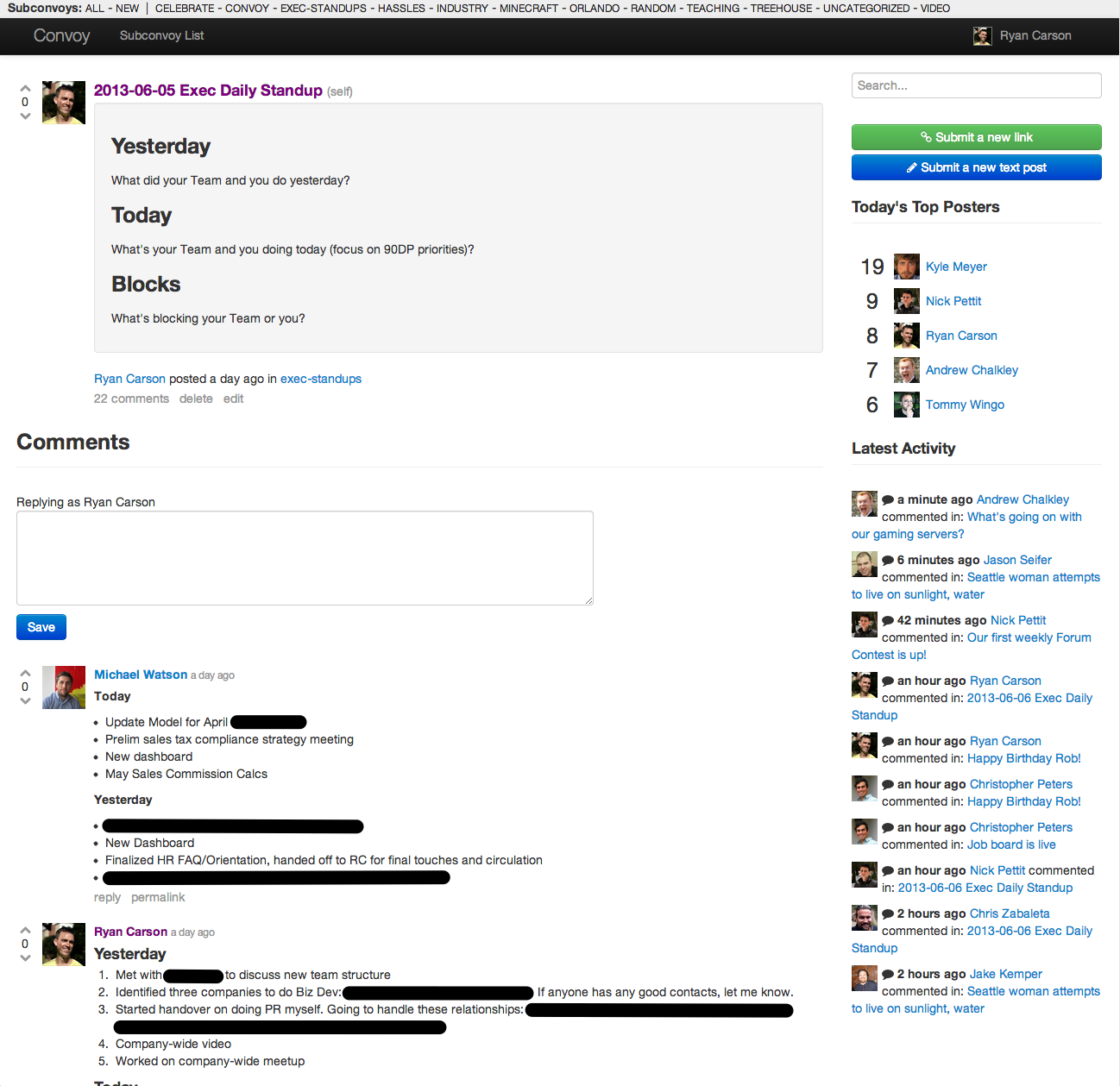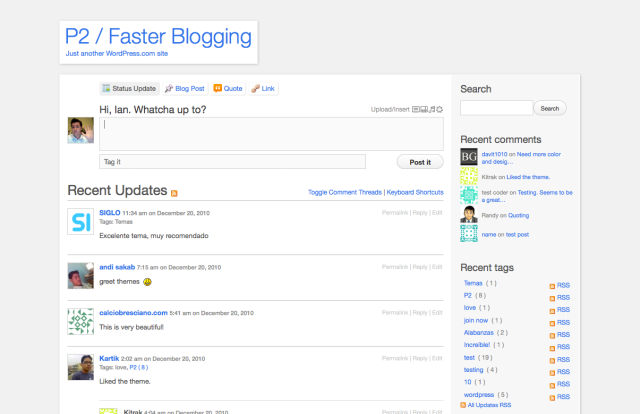- How to Manage a Remote Team
- How to hire a remote team
- How to build culture in a remote team
- How Successful Remote Teams Evaluate Employees: A Look inside Automattic, GitHub, and Help Scout
- How to Build Strong Relationships in a Remote Team
- How to Run a Company Retreat for a Remote Team
- This is What a Remote Office Looks Like
- How to Work Faster in a Remote Team
- How to Find Your Optimal Work Environment and Boost Productivity
- The pros and cons of working across time zones: What to expect when you work in a distributed company
- How to Avoid Burnout in a Remote Team
- How to Thrive as an Extrovert on a Remote Team
- How to Find and Get Hired for a Remote Job
- The remote worker's toolkit: The 15 tools you need to work remotely
- A Special Thanks To Those Who Share: The Best Blog Posts, Articles and Resources on Remote Work
How to End Internal Emails and Communicate Effectively in a Remote Team
"Communication is oxygen."
That portion of the Automattic creed has stuck with me from the start. After reading the creed during my first week of remote work, I had a surface-level understanding. Now, after a year of working with over 250 other individuals spread across the globe, I understand it even more. In many ways, communication is the lifeblood of an organization. Without discussion and collaboration between individuals, little innovation would take place.
It's easy to emphasize the importance of communication in remote work since employees can't meet by the proverbial water cooler. But, it's just as important when employees are working in the same room—launches have to be scheduled, bugs have to be squashed, and relationships must be built.
There are a slew of tools out there for communicating, including Skype, Slack, and HipChat to name a few. However, in some cases, the normal tools just don't get the job done, leading companies to improvise and create their own systems that work. Let's take a look at four companies that have cooked up their own communication tool and three takeaways to apply to your organization.
Related: "The Best Team Chat App for Your Company"
GitHub Built "Team" to Learn What Everyone is Working On

Imagine a team of 240 employees with over 60% working remotely. Now, remove all managers. Finally, imagine deploying code 50 times a day on average. Welcome to GitHub.
GitHub, the company who maintains the best interface for sharing code amongst co-workers, colleagues, and complete strangers, certainly has a unique setup. On top of the notable team structure, GitHub also deviates from mainstream business operations in that the company prefers text to voice meetings. As Zach Holman, an engineer at GitHub, explains on his blog, text offers two main benefits.
-
There is a record of conversation. Particularly, since most of the staff is working remotely, having a stored record of conversations makes it easier for everyone to catch up on what they might have missed.
-
You're able to editorialize your thoughts before pressing
return. In voice meetings, we have an inkling of the direction we want to go, but our ideas often aren't fully formulated leading us to use words like "ah" and "um" as fillers. Through text, employees can be sure they’re projecting their ideas in a clear, concise manner.
To make all of this text chat possible, they use over 185 rooms in the popular collaboration software Campfire, Holman shared in March on his blog, to discuss everything from troubleshooting bugs to passing along hilarious GIFs and chatting about health insurance. However, with all of the chatter going on amongst various rooms, it became hard to answer two pressing questions related to the business: "What are people working on today?" and "What shipped today?"
To answer these two questions, GitHub created their own communication tool called Team. It can be thought of as an internal Twitter/blog containing a mixture of work-related content and personal information. On a given day, Team might have around 12 posts from various employees.

For GitHub, the combination of Campfire, Team, and of course, GitHub for sharing code has largely replaced email while still allowing everyone to communicate and catch-up with conversations over text.
"Something I did want to point out is that there was only one email sent out to the entire company at large: it was an email about next summer's all-hands summit," writes Holman in a post titled "A Day of Communication at GitHub".
Related: "Effective Meeting Tactics employed by Execs at LinkedIn, Amazon and Asana"
Treehouse Constructed a Reddit Clone to Bubble Up Important Items

Treehouse, another remote company of more than 50 team members, uses a variety of communication methods depending on the urgency of the request. For example, they use Campfire for daily banter, email for items that need an answer within the next day or two, and instant messaging for more urgent matters that need addressing within the next hour.
With all of the available tools, they still found a hole in their communication. With Campfire, it was hard to distinguish between important items and chit-chat. When employees were reading through the backscroll, news about a child's birthday appeared to have the same level of importance as crucial business announcements.
To solve this issue, the Treehouse team created Canopy (formerly Convoy), a clone of the social news site Reddit. Any employee can post to Canopy, which has around 15 posts published daily. The topics can range from business-related items to random chatter. As opposed to their other means of communication that generally warrant a response, posts in Canopy don’t require action. They’re meant to inform.
They've also begun using the tool for standup meetings. CEO and co-founder Ryan Carson posts an opening thread with the day's date and the title "Daily Standup" (for example, 2014-12-18 Daily Standup) and then emails a link to participants. When they have time, appropriate parties post a comment with their daily update.
Carson and the team noticed two main benefits immediately. First, threaded comments were way more efficient than email replies, particularly for the Daily Standup. Second, posting information out in the open in Canopy created a sense of transparency within the organization.
"I think everyone feels like they can access whatever information they want and it's not being held back by anyone to advance their personal politics," Carson explains.
Automattic Created P2, a Microblog on its Own Platform

The company behind WordPress.com, Jetpack, and other popular blogging tools previously relied on IRC, Skype, and email for all company communication. Those tools got the job done for quite awhile. Eventually, as you might expect from a company involved with producing the most popular blogging software on the planet, Automattic began using an internal blog featuring long posts and comments. However, the length of posts made it hard to catch up and many employees forgot to visit the internal blog regularly.
To solve this issue, Automattic set out to build a tool that removed the friction from publishing and chronicling daily activity. The result was P2, a sort of microblog where the post box sat on the homescreen making publishing quick and painless.
The tool offered some immediate benefits. First, P2 provides real-time updates without having to reload the page. You can post a status update and immediately watch as comments and reactions came in. Second, since P2 works well on mobile devices and desktops, employees have access to information anywhere and everywhere. Lastly, like Treehouse, Automattic found that opening up information to anyone within the company further reinforced the trusting internal atmosphere. Any employee, new or old, could pull up previous P2 conversations and chime in on current conversations when they had something to add.
P2 has continued to develop over the years and has become a mainstay in inner-workings at Automattic. The company now has well over 150 internal P2s including those focused on specific projects and others devoted to sharing daily banter and awesome GIFs (which are embedded easily into the page).
Since the tool has been so successful within the company, Automattic has made it available to everyone. Anyone can start a blog on WordPress.com and enable the P2 theme. It also comes in the self-hosted variety as well. The tool is currently undergoing an upgrade and will be transformed into a plugin called O2, making it easier for developers to build extensions and themes to integrate with the product.
Zapier Utilizes a Customized Version of P2

Like many other companies, Zapier uses team collaboration and messaging app Slack for daily banter. While the chat tool certainly gets the job done, CEO and co-founder Wade Foster found it was ill-suited for longer discussions.
"It's really noisy so longer running conversations or things that need more visibility tend to get buried quickly," says Foster. To solve this problem, the team began using what they call Async, an internal version of the P2 tool used by Automattic. Async replaced @ team emails that were intended to keep everyone abreast of larger topics.
The team quickly made some adjustments to P2 to fit their needs. First, they added a "Like" button so team members could acknowledge a post without commenting. Second, they added some CSS customizations to modify the P2 theme to fit their internal brand. Finally, as you might expect, they they put a Zap in place to automatically notify them of P2 activity in Slack.
Zapier currently has one internal P2 that gets about 30 updates a week. The posts tend to be 400-800 words long, but conversations are easy to follow since threaded comments are enabled automatically. According to Foster, Async has offered a tremendous boost in visibility across teams.
"The engineering team does a ton in GitHub so there's good visibility there but the marketing and support team don't spend much time there," Foster says. "So the engineering team will surface the best of GitHub in Async so that the whole team has perspective on what's happening there."
Improve Your Internal Communication

You don’t need to start from scratch to create a communication system similar to those used by GitHub, Treehouse, Automattic, and Zapier. Telescope, for example, makes it easy to create a Reddit clone for your company. As mentioned above, anyone can set up a P2 for their company, too.
Regardless of the tool you're trying to build, in learning about the examples above, some overarching principles of communication became clear.
-
Visibility is key. Treehouse, Automattic, and Zapier all acknowledged that sharing information across teams is a huge element of their success.
-
Important topics should bubble to the surface. Like Team, the tool from GitHub that tries to answer the two most important questions of the day, internal tools should help employees to separate out the important issues from the noise.
-
Conversation is encouraged and following along is simple. With Canopy, Treehouse found that threaded comments were much easier than emails for daily meetings. Additionally, other employees could easily follow the conversation as it happened. Communication tools should make it easy for dialogue to occur and everyone to stay on top of what is going on.
In the next chapter, we'll look at 3 strategies to help you build strong relationships even when you're far away from your team.
Written by Automattic Happiness Engineer Jeremey DuVall
Automattic team photo from Matt Mullenweg's blog.
Previous Chapter
How to Thrive as an Extrovert on a Remote Team
Next Chapter
How to Find and Get Hired for a Remote Job

Take the Work out of Workflow
Zapier is the easiest way to automate powerful workflows with more than 5,000 apps.